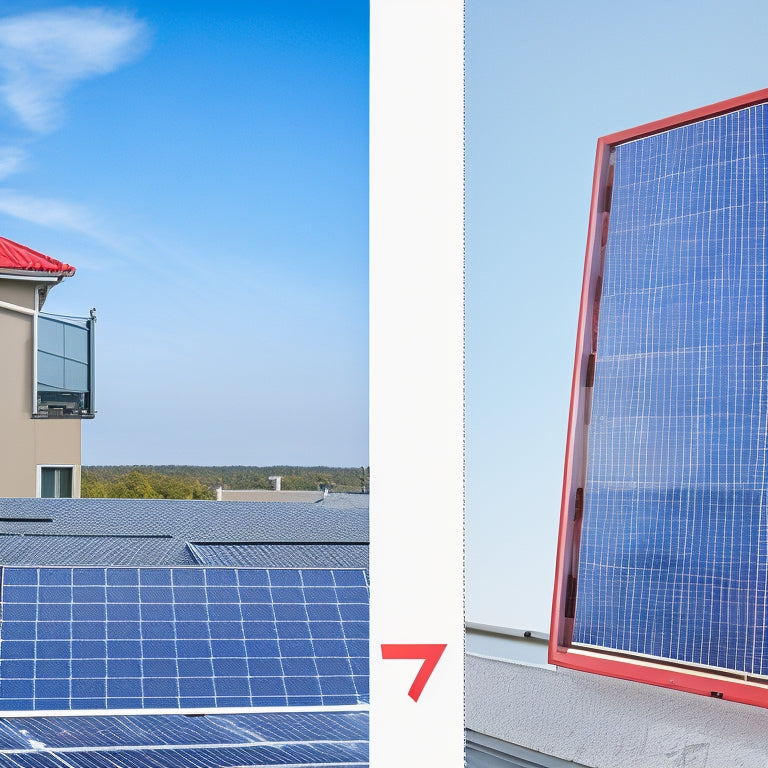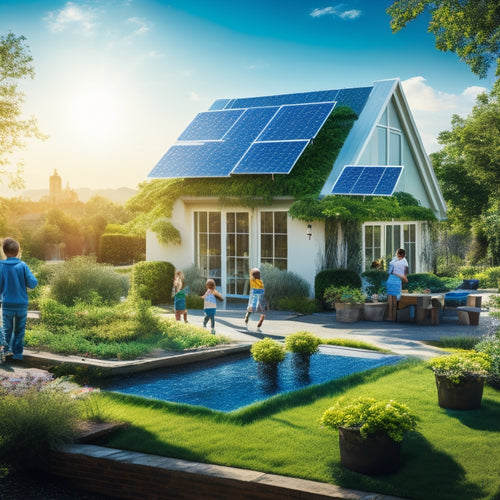
What's Causing the Recent Drop in Solar System Prices for Homes
Share
You're witnessing a dramatic shift in the solar industry, with the average cost of solar systems for homes dropping considerably in recent years, driven by a combination of global supply chain adaptations, technological advancements, intensified competition among installers, favorable government policies, and economies of scale benefits. As you investigate the market, you'll find that improved manufacturing efficiency, increased competition, and government incentives have led to lower prices. Furthermore, advancements in solar panel technology have increased power generation while reducing installation costs. Now, you're likely wondering how these factors intersect to create the perfect storm for affordable solar energy – and that's just the beginning.
Key Takeaways
- Transition to renewable energy and increased demand drive adaptation in sourcing, production, and distribution, leading to lower solar system prices.
- Improved solar panel efficiency and installation costs decrease, making solar energy more accessible and affordable for homeowners.
- Increased competition among installers prompts cost reduction and efficient business models, resulting in lower prices for solar systems.
- Government incentives and policies, such as tax credits and net metering, reduce upfront investments and electricity bills, making solar more affordable.
- Economies of scale benefits from industry expansion allow manufacturers and installers to negotiate better deals on raw materials, reducing costs per unit.
Global Supply Chain Shift
As the world evolves to renewable energy, a global supply chain shift is underway, with manufacturers and suppliers adapting to meet the growing demand for solar panels and related equipment.
You're witnessing a significant alteration in the way solar components are sourced, produced, and distributed. This shift is driven by increasing demand from homeowners like you, seeking to utilize clean energy and reduce their carbon footprint.
However, this rapid growth has led to supply chain disruptions and material shortages. You may have experienced delays in receiving your solar panel shipment or encountered difficulties in sourcing specific components.
These challenges are largely attributed to the surge in demand, which has put pressure on manufacturers to keep up with production. As a result, prices for solar systems have fluctuated, making it essential for homeowners to stay informed about the market trends and supplier capabilities.
Understanding these forces will help you maneuver through the intricacies of the solar industry and make informed decisions about your renewable energy investment.
Technology Advancements Drive Costs
You've likely noticed that solar system prices for homes have been steadily decreasing over the years, making renewable energy more accessible to homeowners like you. This downward trend is largely driven by technology advancements, which have improved solar panel efficiency and streamlined installation processes.
| Year | Solar Panel Efficiency | Installation Cost ($/Watt) |
|---|---|---|
| 2010 | 15% | $3.80 |
| 2015 | 18% | $2.80 |
| 2018 | 20% | $2.30 |
| 2020 | 22% | $1.90 |
| 2022 | 24% | $1.60 |
As shown in the table, solar panel efficiency has increased by 9 percentage points over the past decade, allowing homeowners to generate more power from the same surface area. Installation innovations, such as robotics and AI-powered installation tools, have also reduced labor costs and improved installation speed. These advancements have cumulatively driven down the cost of solar system installations, making renewable energy a more viable option for homeowners like you.
Increased Competition Among Installers
Driving down solar system prices for homes isn't only a result of technology advancements but also increased competition among installers.
As you consider investing in solar energy, you'll notice that the market has become increasingly saturated with installers vying for your business. This surge in competition has led to a shift in installer strategies, with many focusing on reducing costs to stay competitive.
To remain profitable, installers are adopting more efficient business models, streamlining their operations, and renegotiating contracts with suppliers. This, in turn, allows them to offer lower prices to customers like you.
Additionally, the rise of new market entrants has forced established players to re-evaluate their pricing structures, leading to a downward pressure on costs.
As a result, you're now seeing more affordable solar system options available for your home. With increased competition comes better value for your money, and you can expect to see continued downward pressure on prices as the market continues to evolve.
Government Incentives and Policies
How do government incentives and policies impact the cost of solar systems for homes? As you consider investing in renewable energy, you're likely wondering how government initiatives affect your bottom line. The good news is that government incentives and policies have played a notable role in driving down the cost of solar systems.
Here are 4 ways government support has made solar energy more affordable:
-
Tax credits: You can claim a tax credit of up to 26% of the total cost of your solar system, notably reducing your upfront investment.
-
Net metering policies: These policies allow you to sell excess energy back to the grid, offsetting your electricity bills and increasing your savings.
-
Renewable portfolio standards: By setting targets for renewable energy adoption, governments have created a market-driven demand for solar energy, driving down costs.
- State and local incentives: Many governments offer additional incentives, such as rebates, grants, or property tax exemptions, to encourage homeowners to switch to solar.
These government incentives and policies have created a supportive environment for the growth of the solar industry, ultimately benefiting you, the homeowner, with lower prices and increased accessibility to renewable energy.
Economies of Scale Benefits
As the solar industry expands, manufacturers and installers are reaping the benefits of economies of scale, which in turn are being passed down to homeowners in the form of lower prices.
This means that as production volumes increase, manufacturers can negotiate better deals on raw materials and components, resulting in lower costs per unit. You're benefiting from bulk purchasing, where manufacturers buy materials in large quantities, reducing their costs and subsequently, yours.
Manufacturing efficiencies also play a significant role in reducing costs. As production scales up, manufacturers can invest in more efficient equipment and processes, streamlining their operations and reducing waste.
This leads to higher-quality products at lower costs. Additionally, installers can also benefit from economies of scale by optimizing their installation processes, reducing labor costs, and passing the savings on to you.
With the solar industry continuing to grow, you can expect to see even more competitive pricing as economies of scale benefits continue to trickle down to homeowners.
Frequently Asked Questions
Can I Install Solar Panels on My Own to Save More Money?
You can attempt a DIY installation to maximize cost savings, but consider the complexity and potential risks; improper installation may void warranties, compromise efficiency, and even pose safety hazards, so weigh the trade-offs carefully.
Will Solar Panels Increase My Home's Resale Value?
You're sitting on a goldmine, and installing solar panels can be the catalyst to enhance your home value. This savvy solar investment can increase your property's appeal, making it more attractive to potential buyers and ultimately, padding your wallet.
How Long Does It Take to Install Solar Panels on a Home?
You'll typically spend 1-3 days overseeing the installation process, but the actual installation timeline can take around 2-5 days, depending on the complexity of the job and the number of panels being installed on your home.
Are Solar Panels Durable Enough to Withstand Harsh Weather?
You'll be glad to know that solar panels are built to last, with durable materials designed to withstand harsh weather conditions, including heavy rain, hail, and extreme temperatures, ensuring your system remains efficient and reliable over time.
Can I Use Solar Panels to Power My Electric Vehicle?
As you rev up your electric vehicle, imagine utilizing the sun's energy to fuel your ride; with solar panels boasting 20% efficiency, you can charge your EV, enjoying a guilt-free commute, and even selling excess power back to the grid.
Conclusion
As you consider going solar, you're likely wondering why prices have dropped so remarkably. The truth is, it's not just one factor - it's a perfect storm. The global supply chain has shifted, technology has advanced, and competition among installers has increased. Government incentives and policies have also played a role, and economies of scale have brought costs down. The result? Solar system prices for homes have plummeted, making it an increasingly affordable option for you.
Related Posts
-

Solar Energy Benefits for Sustainable Living
Solar energy provides numerous benefits for sustainable living that you can't overlook. By switching to solar, you'll...
-

Solar Inverter Troubleshooting for Beginners
Troubleshooting your solar inverter starts with understanding its efficiency and performance metrics. Check for prope...
-

How to Reduce Home Energy Bills
To reduce your home energy bills, start by investing in energy-efficient appliances and upgrading your insulation. Lo...


